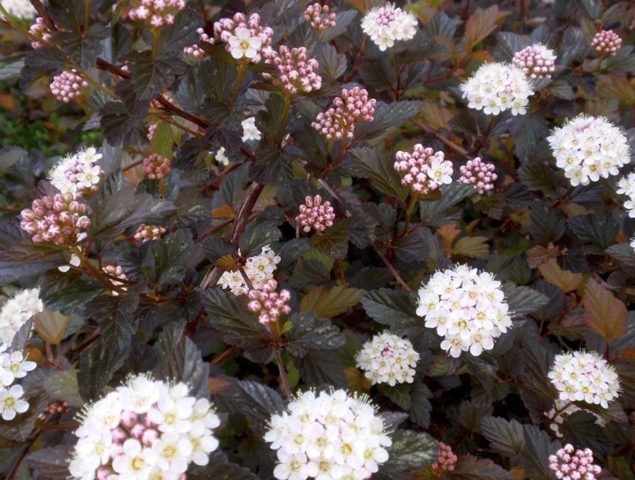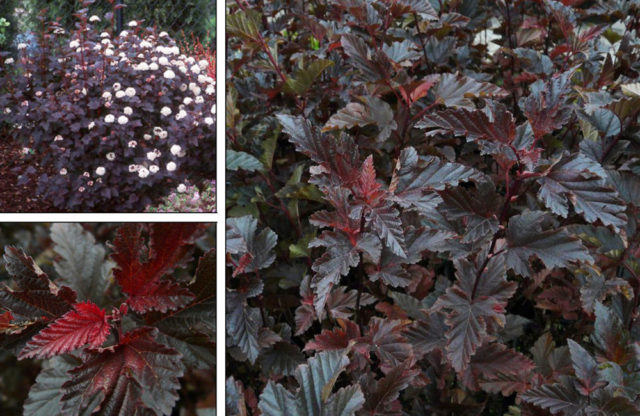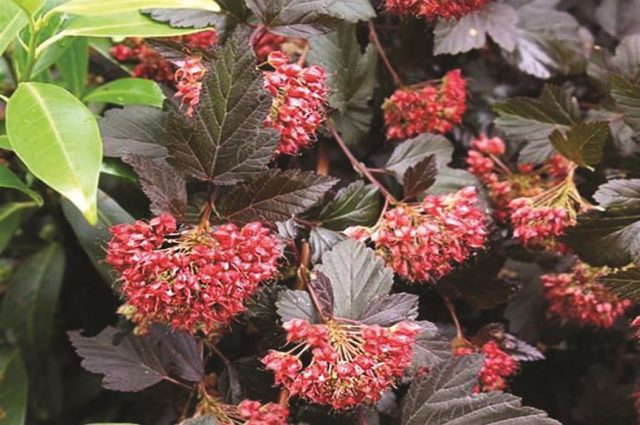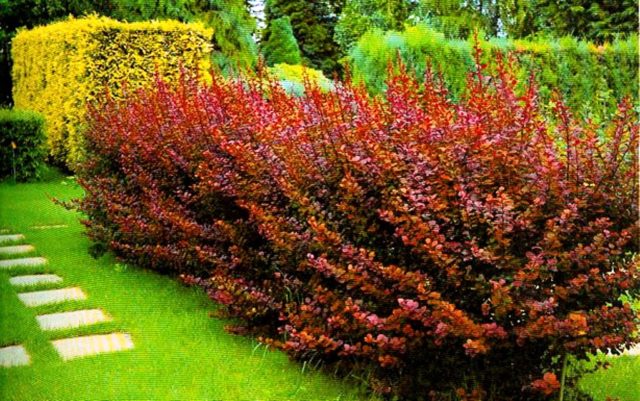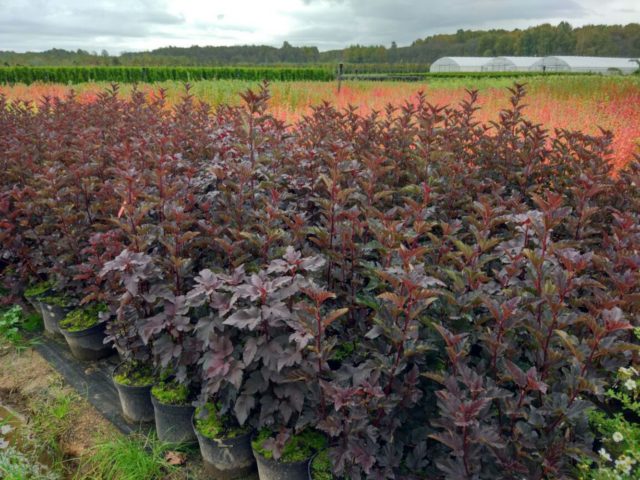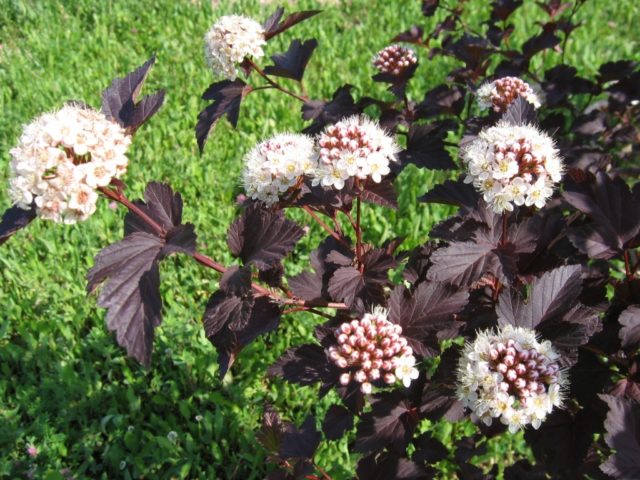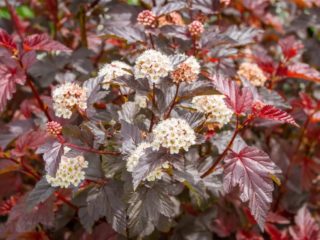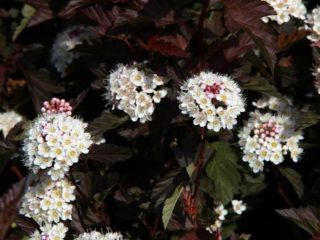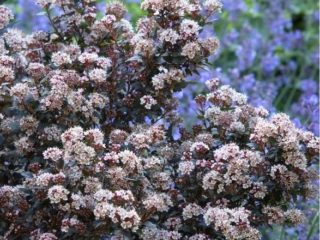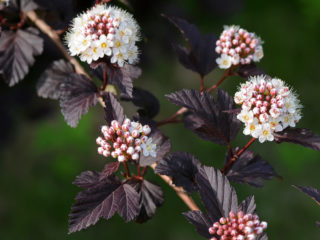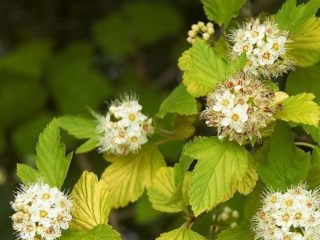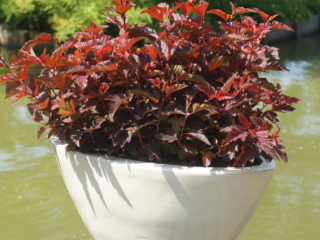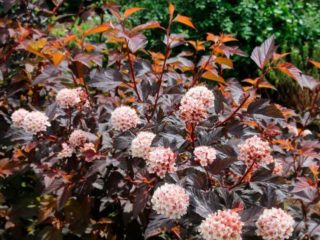Content
Red Baron bladderwort is rightfully considered one of the most original shrubs. Gardeners liked it not only for its unusual and chic appearance, but also for its ease of care. Red Baron grows quickly, while maintaining its decorative value throughout the growing season, and is therefore widely used for landscaping city parks and private households.
Description of the Red Baron bladderwort
Red Baron bladderwort was brought from North America, where it most often grows on river banks. The bush is tall and belongs to the viburnum-leaved species. Its five-lobed leaves are very reminiscent of viburnum leaves. The flowering period begins in June-July. The fruits ripen in early September.
Description of Red Baron viburnum
Height | about 2 m |
Bush shape | round, spreading |
Branches | arcuate |
Flowers | white-pink with a red stamen, collected in inflorescences, hemispherical, corymbose in shape |
Fruit | prefabricated, red blown leaflets |
Leaves | 5-7 lobed, 7-10 cm in diameter, rounded-elliptical in shape, dark red in color, which becomes bronze in autumn, in the shade the foliage is green, with a reddish tint |
Red Baron bladderwort in landscape design
Red Baron is popular among landscape designers due to its unusual appearance. All its parts are decorative, including foliage, flowers, and fruits. You can meet the bladderwort on city streets and in rural courtyards. Park areas, front entrances, and summer cottages are decorated with this bright shrub.
Red Baron often becomes an element of complex garden compositions, in which it can occupy both a dominant position and act as a background for other plants. The bladderwort bush can be an excellent tapeworm in the undergrowth, against the background of deciduous and coniferous compositions.
Red Baron looks great in single and group lawn plantings. An original design solution is to trim the bushes. At the same time, the bladderwort gets a unique shape, which in combination with other garden crops gives an amazing effect.
Hedges made from Red Baron bladderwort (pictured) can adequately decorate any recreation area or garden of a country house. They turn out dense, thick and incredibly beautiful, without requiring special care.
Conditions for growing Red Baron bladderwort
The features of growing Red Baron vesicle carp are almost the same as those of other varieties of vesicle carp.Red Baron is a rather unpretentious plant that prefers sunny areas, but can also grow in partial shade. The bladderwort, growing in sunny places, gets the opportunity to fully reveal the decorative qualities of its foliage. Whereas in the shade it acquires a green color, the saturation of which depends on the degree of illumination.
Planting and caring for Red Baron bladderwort
Red Baron bladderwort, according to the description of the variety, does not require any specialized care, but will only fully develop when the following agrotechnical measures are carried out.
Watering | 2-3 times a week, especially during hot periods |
Top dressing | in the spring-autumn season |
Loosening the root circle | regularly, being careful not to damage the root system
|
Soil treatment against pests | in the spring for preventive purposes |
Trimming | 2 times per year |
Preparing the landing site
It is recommended to choose a site for planting Red Baron bladderwort with loose soil rich in nutrients. But due to its undemanding nature, bladderwort will also grow on insufficiently fertile substrates. The composition of the soil can be completely different, the main thing is that there is no lime in it. Also, the bladderwort develops quite poorly on soils with high groundwater levels.
Landing rules
Planting Red Baron bladderwort begins with preparing a planting hole for the seedling. Step-by-step process of preparatory and planting work:
- Dig a hole of sufficient depth (the root collar should be flush with the ground).
- Place a layer of nutritious, fertile soil at the bottom.
- Place the seedling vertically in the hole.
- Sprinkle the root with soil, lightly tamping it down.
- Water the seedling.
- After three to four days, loosen the soil.
- Mulch the root zone with peat, humus or dry soil to retain moisture.
When planting, the branches of the seedling should not be buried more than 1-2 cm into the ground. Some time after shrinkage, soil must be added to level the surface. Hilling up is not recommended.
When planting Red Baron bladderwort to create a hedge, the seedlings should be placed in a checkerboard pattern (in a two-row manner).
Recommended distance:
- in rows – 35 cm;
- between seedlings – 45 cm.
Watering and fertilizing
The frequency of watering Red Baron bladderwrack bushes depends on a number of factors, such as:
- type of soil;
- plant age;
- climatic region in which the shrub grows.
Ornamental bushes of the Red Baron variety should be watered regularly, 2-3 times a week. The water consumption rate per plant is about 40 liters.
It is necessary to feed the viburnum leaf carp:
- in early spring - nitrogen fertilizers;
- in autumn - mineral.
Top dressing (per 10 liters of water) | |
in the spring | in autumn |
· mullein – 500 ml; · carbamide (urea) – 25 g; · ammonium nitrate – 25 g. | · mullein – 500 ml; · carbamide (urea) – 25 ml; · ammonium nitrate – 25 ml; · phosphorus nitrate – 50 ml. |
Trimming
Red Baron viburnum is a fast-growing variety. Growing in comfortable conditions, the bush can produce about 40 cm of growth in both width and height in a year. Therefore, the plant needs not only sanitary pruning, but also formative pruning. The procedure is not traumatic for the plant. The bushes easily tolerate it and very quickly sprout new shoots.
Sanitary pruning is carried out in the spring. Its main purpose is to remove broken and frozen branches. Bush-forming pruning helps give the bush the necessary shape and stimulates branching. It is carried out in the spring (before buds open) or in the fall (after the end of the growing season).
Red Baron, like other varieties of vesicular carps, grows like a fountain, and correctly carried out formative pruning helps to activate the growth processes of the upper buds. Crown-forming pruning can be done in two ways:
- The trunks of the bush are cut at a height of 40-50 cm to obtain a powerful, wide bush.
- At the base of the bush, all thin and weak shoots are removed.Leave about five of the strongest trunks, cutting them at a height of 1.5 m, thereby stimulating their growth. At the same time, the bush acquires a pronounced fountain-like shape.
Preparing for winter
The Red Baron bladderwort is resistant to slight drops in atmospheric temperatures, but in severe winters, young shoots can sometimes freeze. In order to prevent possible freezing, the bushes should be properly prepared for wintering in the fall. It is recommended to begin preparatory work with the arrival of the first cold nights.
Step-by-step plan for insulating the viburnum vesicle:
- The bushes are tied together with rope or twine.
- Wood shavings or peat are laid out around the trunk of the plant.
- The shrub is covered on top with any natural insulating material.
Reproduction of Red Baron.
Red Baron viburnum leaf carp reproduces:
- layering;
- cuttings;
- dividing the bush.
Propagation of the vesicular carp by layering gives good results. For layering on adult bushes, strong, healthy shoots that grow outward are selected. Before planting, all foliage is removed from them, with the exception of the top. Then they make a groove 15 cm deep, into which the prepared shoot is placed. Be sure to secure the layer by pinning it to the ground, for example, with wooden or metal brackets.The top of the hole must be covered with earth. In the fall, the cuttings are separated from the bush and planted in a permanent place.
Cuttings for propagation are prepared as follows:
- Before flowering begins, young branches at least 20 cm long are cut from the bushes.
- The leaves are removed from the lower part of the shoot, and the remaining ones are shortened by half.
- The branches are placed in the Kornevin solution for 2-3 days.
- When the first signs of the formation of a future root system appear, the cuttings are planted in nutrient soil.
- The seedlings are covered with film for the summer, periodically ventilated and watered. They are insulated for the winter.
Dividing the bush is the fastest way to propagate. But due to the fact that adult bushes have a highly developed root system, this option is quite labor-intensive.
Diseases and pests
Red Baron bladderwort is highly resistant to many diseases and pests. But for preventive purposes, it is recommended to carry out spring tillage of the soil with antifungal and bacterial drugs. This procedure will contribute to better development of the bush and its growth.
For hygienic purposes, it is recommended to add drugs such as Fitosporin, Alirin, and Gamair to the water for irrigation. The dosage is prescribed in the instructions for each specific product. Watering is carried out in the spring, and one such preventive procedure is enough to protect plants for the entire growing season.
Sometimes Red Baron bladderwrack bushes can become affected by blight.The disease develops when plants grow in poor soils. In particular, it is provoked by a lack of iron in the soil. A characteristic sign of the disease is the rusty color of young leaves and shoots, followed by their drying out. The cause of the disease can be eliminated by watering the bushes at the roots with iron-containing preparations (“Firolitam”, “Iron Filate”).
Conclusion
Red Baron bladderwort stands out among most garden plants due to its unpretentiousness and excellent decorative qualities. The plant looks very chic in the garden, decorating it with its leaves that change color depending on the time of year, beautiful spring flowers and autumn berries.
Reviews of Red Baron vesicle
